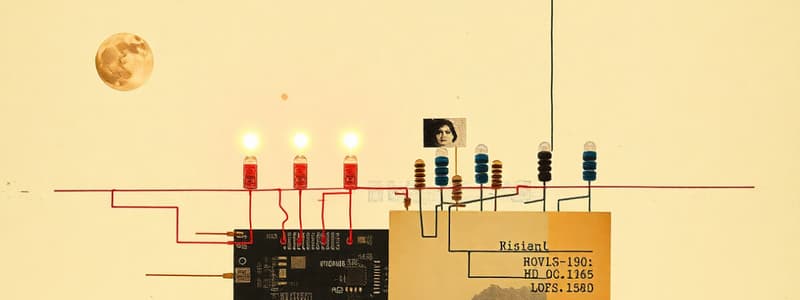Podcast
Questions and Answers
What is the consequence of connecting an LED in reverse orientation?
What is the consequence of connecting an LED in reverse orientation?
- LED will operate normally
- Potential damage to the LED (correct)
- Increased brightness of the LED
- Improved efficiency of the circuit
How is the appropriate resistor value calculated for a single LED when supplied voltage, forward voltage, and forward current are known?
How is the appropriate resistor value calculated for a single LED when supplied voltage, forward voltage, and forward current are known?
- Resistor = Forward voltage / (Supplied voltage - Forward current)
- Resistor = (Supplied voltage + Forward voltage) / Forward current
- Resistor = Supplied voltage / Forward current
- Resistor = (Supplied voltage - Forward voltage) / Forward current (correct)
According to Kirchhoff's Voltage Law for a series circuit, what does the total supply voltage equal?
According to Kirchhoff's Voltage Law for a series circuit, what does the total supply voltage equal?
- The total current multiplied by the total resistance
- The forward voltage of the LED multiplied by the current
- The voltage drop across the resistor only
- The sum of the voltage drop across the LED and the resistor (correct)
What is the typical result of using a resistor value lower than what is calculated for the LED?
What is the typical result of using a resistor value lower than what is calculated for the LED?
When connecting multiple LEDs in series, what step must be taken before calculating the required resistor?
When connecting multiple LEDs in series, what step must be taken before calculating the required resistor?
What is the consequence of using a resistor that is too high in value when connecting an LED?
What is the consequence of using a resistor that is too high in value when connecting an LED?
What does the term 'forward voltage' refer to in the context of LEDs?
What does the term 'forward voltage' refer to in the context of LEDs?
When connecting multiple LEDs in series, which calculation is necessary before determining the required resistor?
When connecting multiple LEDs in series, which calculation is necessary before determining the required resistor?
Which of the following statements best describes Kirchhoff's Voltage Law in relation to LEDs?
Which of the following statements best describes Kirchhoff's Voltage Law in relation to LEDs?
What is a potential danger of connecting an LED in reverse orientation?
What is a potential danger of connecting an LED in reverse orientation?
What happens if the calculated resistor value is applied in an LED circuit?
What happens if the calculated resistor value is applied in an LED circuit?
What is the typical value of a current limiting resistor needed when the supplied voltage is greater than the forward voltage of an LED?
What is the typical value of a current limiting resistor needed when the supplied voltage is greater than the forward voltage of an LED?
Flashcards
LED Polarity
LED Polarity
LEDs have a positive anode (longer leg) and a negative cathode (shorter leg). Incorrect polarity can damage the LED.
Current Limiting Resistor
Current Limiting Resistor
A resistor used in LED circuits to prevent excessive current, which can damage the LED.
Calculating Resistor Value
Calculating Resistor Value
Determine LED forward voltage, subtract that and total forward voltage (if multiple LEDs) from supplied voltage, then divide by desired forward current to calculate the required resistor value. Use the next higher standard resistor size.
Forward Voltage
Forward Voltage
Signup and view all the flashcards
Calculating total LED forward voltage
Calculating total LED forward voltage
Signup and view all the flashcards
Forward Voltage (Vf)
Forward Voltage (Vf)
Signup and view all the flashcards
Calculating Resistor for LEDs
Calculating Resistor for LEDs
Signup and view all the flashcards
Multiple LEDs in Series
Multiple LEDs in Series
Signup and view all the flashcards
Kirchhoff's Voltage Law (LED Circuit)
Kirchhoff's Voltage Law (LED Circuit)
Signup and view all the flashcards
What happens when you press a switch?
What happens when you press a switch?
Signup and view all the flashcards
Safe Operating Current (Forward Current)
Safe Operating Current (Forward Current)
Signup and view all the flashcards
Study Notes
LED Polarity and Position
- LEDs have a positive anode (longer leg) and a negative cathode (shorter leg).
- Incorrect polarity can damage the LED.
Current Limiting Resistors
- Always use a current limiting resistor with LEDs to prevent excessive current and potential damage.
- Higher current leads to brighter light, but excessive current will damage the LED.
- Use a forward current rating suitable for continuous operation.
Calculating Resistor Value
- Identify the supply voltage and the LED's forward voltage.
- Add forward voltages for multiple LEDs in series.
- Calculate the necessary resistor value using the formula: (Supply Voltage - Total Forward Voltage) / Desired Forward Current.
- Round up to the nearest standard resistor value.
Example Resistor Calculation
- Supply voltage: 9V
- Forward voltage: 2V
- Forward current: 20mA (0.02A)
- Resistor Value: (9V - 2V) / 0.02A = 350Ω
- Use a 360Ω standard resistor.
Typical Forward Voltage
- Typical forward voltage is the voltage drop across the LED when operating.
Kirchhoff's Voltage Law
- In a series circuit, the voltage drop across the resistor and LED equals the total supply voltage.
Switches
- Switches do not have polarity.
- Pressing the button closes the circuit, allowing current flow.
- Releasing the button opens the circuit, stopping current flow.
Example Circuit Calculation
- A yellow LED (2.1V) and an infrared LED (1.2V) in series:
- Total forward voltage (Vf) = 2.1V +1.2V = 3.3V
- Need to subtract that from the battery source
- Divide by the continuous forward current to know the correct resistor.
Studying That Suits You
Use AI to generate personalized quizzes and flashcards to suit your learning preferences.




